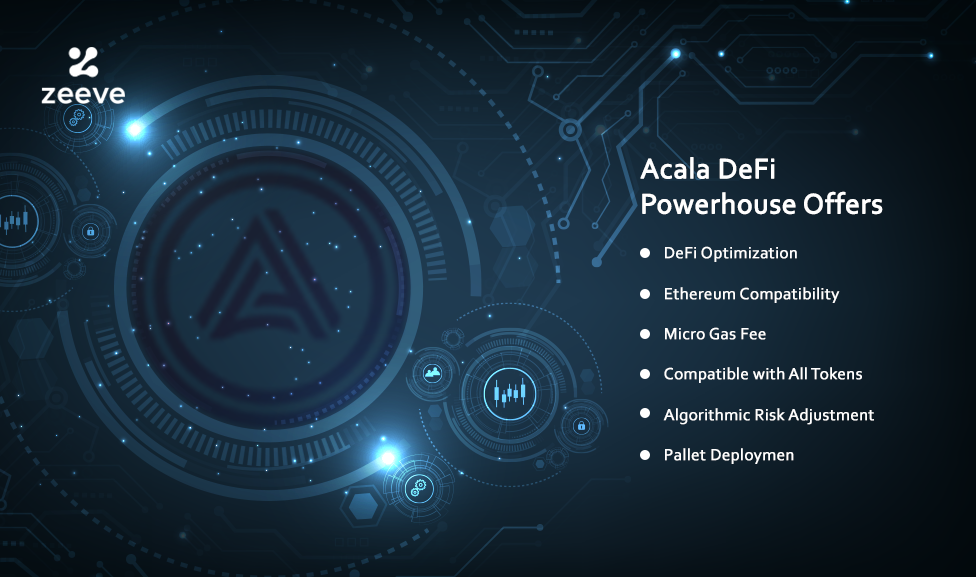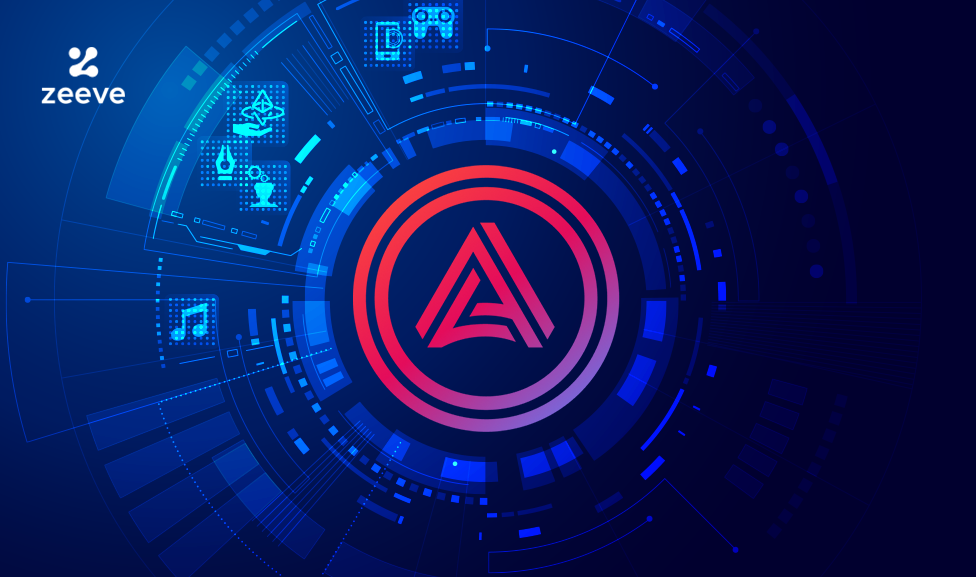DeFi is the talk of the town among the regulators, investors and financial institutions. As it gives the users control over their finances by providing no tampering with the database. Centralization keeps you at the edge with the security of assets at stake. Mostly, the layer 1 smart contracts majorly focus on DeFi.
While a decentralized network gives multiple benefits along with control. The merge of traditional finance with smart contracts deployment takes away all the fun. The reason being networks are already brimming with traffic. There should be a network which brings ease in adopting DeFi.
There comes Polkadot, a network with interoperability protocol. Acala network is a DeFi platform that is built on the Polkadot ecosystem. With its vibrant community and a full-fledged focus on retaining the title of DeFi Powerhouse. The network supports a fast, easy-to-use, and easy-to-build DeFi ecosystem.
In this guide, we will learn more about the Acala network. Further, will know about its pool of offerings and more on how it is planning to grow its empire in 2023. Keep reading!
An Introduction to Acala Network
Acala is custom-built for DeFi. The Layer-1 network is built to host a wide range of financial services. The application specific blockchain network offers smart contract functionality, interoperable cross-chain technology, and robust security. It is built on the Polkadot ecosystem and is compatible with Ethereum. The network is a powerhouse for DeFi services.
Fully optimized for DeFi brings together the best of Ethereum and the full power of the substrate. Acala gets the tag of a powerhouse as it has its own Automated Market Maker (AMM) and a decentralized exchange. Acala has a major share on the Polkadot Ecosystem, around $214.4M. A strong 2022 in terms of the lineup of products delivered and the integration. The DeFi powerhouse parachain also won the first parachain auction on Polkadot.
Acala Token — ACA
The native token of Acala is ACA. It serves three major functions. Firstly, ACA is used for paying transaction fees, stability fees, and penalty fees. Secondly, ACA proposes risk adjustment and network upgrades. Lastly, the tokens can be used as a medium of exchange and payment for the stability fees and for closing CDPs. A portion of tokens are redistributed to the developers on the platform in the form of grants, for the development of the Acala platform.
Acala Dollar Stablecoin — aUSD
Acala Dollar (aUSD) is the network’s stablecoin. Users can create aUSD using the assets from any blockchains linked with the Polkadot chain. In 2023, there will be a fourth liquidation method for aUSD, making it more accessible to regular users in collaboration with Kujira. The best part about aUSD is that it’s decentralized.
The Value of Acala Offers
Acala Network started its journey in 2019 along with building Polkadot and Substrate. The network is a launching pad for Ethereum DeFi to get access to the Polkadot. The DeFi apps are built on two protocols known as Homa and Honzon. The Honzon is for cross-chain stablecoin protocol and Homa is for tokenized staking liquidity protocol. A bit more about the two protocols on which Acala runs:
- Honzon: The protocol allows users to make cryptocurrency deposits on a different network. At the same time, it creates a collateralized debt position. CDPs can also be used for making loans. This can be used across different networks which are connected to the Polkadot Chain. The multi-collateralization of the Honzon protocol allows the minting of more amount of aUSD.
- Homa: The protocol enables the staking of Acala. Furthermore, the exchange of the Polkadot tokens (DOT) into liquid tokens (L-DOT). Further, one can use the liquid token across other networks. This solves the problem of capital inefficiency and security risk.
Acala has built Acala EVM+ to join Ethereum and substrate. The network also built the stablecoin distribution system to enhance the stablecoin liquidity and efficiency.
Polkadot’s Economic Hub
The network hosts a crowdloan to gather Polkadot-native decentralized stablecoin (DOT) tokens. The platform is built on top of the Polkadot network and follows the nominated proof-of-stake (NPoS) model. The stablecoin is helpful in universal trading pairs and routing to all the assets in the ecosystem.
DeFi Optimization
Acala’s chain offers DeFi customization. Further, the developers don’t need to fork the system to integrate any new features. The on-chain keepers automate protocol execution to manage risks better and improve UX. The assets compound through liquid staking on Acala, leaving more possibilities for usage. Forkless upgrades and on-chain governance makes the network the best among its contenders.
Ethereum Compatibility
As Polkadot is easily integrated with Ethereum and Bitcoin. Similarly, Acala is compatible with both Ethereum and Substrate for Polkadot DeFi. Furthermore, compatible with established tech stacks and wallets such as Metamask. This reduces the hurdles for developers and gives them a lot more space for innovation.
Micro Gas Fee
Acala follows a weight-based fee model. You can count the micro gas fees that vary according to the transaction complexity. The transaction fees are settled using ACA. This is the reason the fee token should have a liquidity pool with aUSD.
Compatible with All Tokens
One can submit the transaction fees with virtually any token. This reduces friction. The aUSD is integrated seamlessly into all substrate-native dapps and other EVM-compatible dapps on any parachain. Therefore, the network is catering to true interoperability.
Algorithmic Risk Adjustment
To support more returns, there is an auto-adjustment of the various risk parameters, such as interest rates or collateral ratios. Better the risk assessment more secure the network will be.
Pallet Deployment
It allows the deployment of substrate pallets (runtime modules) on the Acala blockchain by staking ACA. With the module deployment, the Solidity contracts can run on Acala. Moreover, the network supports the ink contract pallet, which allows smart contracts written in Rust language.

Sister Network Karura
Acala’s sister network Karura is Kusama’s multi-chain liquidity and economic center. It is the DeFi hub for Kusama (the multi-chain network of Polkadot) and is an initiative for radical innovation. Karura is a scalable, EVM-compatible network and offers — trustless staking derivative, aUSD, and DEX.
The sister network has better governance and a high-risk tolerance. Karura is built to deliver DeFi products and assets to Kusama’s ecosystem. By becoming a liquidity provider on the Karura network, one can earn in two ways: exchanging fees from Karura Swap and fee profit sharing. Both Acala and Karura operate in parallel and serve users of Polkadot and Kusama, respectively.
How Acala Plans to Grow in 2023
In a recent podcast between Dan Reecer and Betty Chen one thing was pretty evident that the network is confident with their 2023 plans and are welcoming to all the centralized institutions.
Any individual protocols and centralized entity that integrates with Acala with ACA token and aUSD with any protocols are free to operate in their way as all the transactions are open & transparent.
– Betty Chen, Co-founder, Acala
In 2023, the network will work on the resurgence of decentralization. There will be a major focus on-chain verifiability. The distribution of real yield and value will become important for further adoption. The centralized entities require more compliance transparency to see growth. 2023 leaves no space for an “illusion” of yield.
There are 4 major aspects in which the Acala network will expand its services.
- Security and monitoring: To build the open-source Polkadot system, tools such as Chopsticks are under development. To monitor the cross-chain movement and to enhance security, the network will add rate limit functionality.
- Product range: A lot of effort is made for Acala apps 2.0, Real yield product enhancements, and numerous growth initiatives in collaboration with Tapio. Building an interchain-proof oracle network for the app’s synchronous and trustless state reading, cross-chain proof of reserves, cross-chain smart contracts, execution/automation, and more.
- Institutional integrations: Institutional DOT Liquid staking, which Acala is planning to power. Integration with Liquid collective in collaboration with Alluvial, Coinbase, and Kraken. There will be continuous development and integration with fintech backend integration. And numerous enterprise brand loyalty programs.
- Governance: In 2023, there will be a phase of governance 2.0 on Acala and Karura to deploy a new governance system. Moreover, there is a plan to renew the Acala Parachain Slot in Q4 2023.
Final Note
As the DeFi ecosystem continues to grow exponentially, We will witness the biggest use case in the DeFi space called — Acala. Every organization and individual needs to understand that DeFi’s popularity isn’t superficial. Of course, there are regulatory challenges. Still, at present, Acala is one of the brightest in the crypto and DeFi network. The decentralized financial hub with robust security and true interoperability.
Helping to explore the cross-chain DeFi deployment, Acala is known for having immense opportunities for technical, funding, marketing collaborations, and much more. Explore the ecosystem today with Zeeve!
Partner with Zeeve
Zeeve is the best platform for Acala for both developer APIs and dedicated full nodes. Launch your Acala blockchain node with Zeeve hassle-free. Understand more about Acala Blockchain Deployment and management here.
Zeeve is the leading Web 3.0 and Blockchain Infrastructure Management platform trusted by thousands of Blockchain Startups, Enterprises, and Web 3.0 Developers. To learn more about Zeeve, feel free to connect with us on Twitter and Telegram. For more details, schedule a free call.





